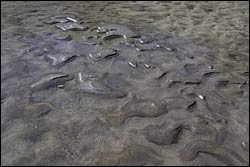Fine sediment: bringing the geomorphology and biology together
Research Status: Future |
Fine sediment in river cobbles |
Introduction
The interest in fine sediment was primarily driven by the perception that the decline in trout numbers in the river in the mid-1990s was related to sediment impacts, with the finger pointed at forestry operations as the source of this sediment. There were also concerns related to mortality of scallops in areas of Tasman Bay near the Motueka River mouth.
Research Approach
When the sediment research in the ICM programme was formulated, the primary goal was “to develop an understanding (and ultimately model) of sediment impacts on freshwater and marine ecosystems, and how we might manage those impacts”.
This overarching goal also includes research in the following areas:
a) Identify sediment sources, loads and transport in different parts of the catchment;
b) Determine how changes in sediment loads and storage influence river morphology and habitat quality;
c) Investigate the links between sediment loads and ecological impacts in the river and bay;
d) Establish the impact of gravel extraction on riverbed levels;
e) Review the management options that can be used to limit sediment generation, movement and delivery to waterways.
Fine sediment was also a focus of the collaborative learning group on sediment as part of the human dimensions research.
Research Results
What we have done so far is reasonably extensive and includes:
- reviewing existing data/information sources on erosion and sediment in the Motueka Catchment and the literature on the effects of fine sediment on river biota;
- identifying sediment sources in the Motueka River;
- establishing a suspended sediment monitoring network; sampled stream invertebrate density and community composition once at 46 sites throughout the Catchment;
- reviewed the literature on sediment measurement techniques and decided on a semi-quantitative method for assessing the composition of riverbed substrate;
- established a network of approximately 28 sites where sediment composition in the riverbed will be characterised annually using the above method (river bed substrate characterisation);
- investigated the effects of a near-bottom high turbidity layer on scallop feeding in Tasman Bay;
- compared the biota present on coarse and fine substrates in the Motueka Delta and offshore plume regions with reference sites in other parts of Tasman Bay;
- identified the ultramafic geology of the Red Hills as a natural source of elevated nickel and chromium containing sediments delivered to the mainstem of the Motueka River and Tasman Bay;
- produced model simulations and theoretical spatial patterns of suspended sediment deposition in Tasman and Golden Bay under contrasting river flow and wind direction scenarios;
- established a long-term in situ data collection facility in the Motueka River plume of Tasman Bay;
- identified a variety of physical, chemical and biological indicators of sediment related terrestrial influences on seabed habitats in Tasman Bay.
 |
 |
Mud |
Fine sediment - Motueka Gorge |
Recent Publications
Recent Presentations
| Year | Title | File Size |
| 2007 | Sediment dynamics and biological impacts in the Motueka River, New Zealand. |
|
BMPs, BEPs and Guidelines
| Title | Description |
| Using Gravel Extraction to Restore Backwaters | Guidelines for creating backwaters...More » |
| Southland’s Wetlands assessment Guide | A tool kit for use by landowners that includes practical advice and assistance to encourage the main...More » |
| Soil Conservation Technical Handbook | The Soil Conservation Technical Handbook is a comprehensive collection of know how about soil conser...More » |
| Clean Streams: A Guide to Managing Waterways on Tasman – Marlborough Farms |
From booklet: This booklet provides information about how to manage waterways to improve water...More » |
| Using Gravel Extraction to Restore Floodway Ponds | Guidelines for restoring floodway ponds...More » |
| Using Gravel Extraction to Restore Oxbow Lakes | Guidelines for restoring oxbow lakes for flood protection...More » |
| Using Gravel Extraction to Restore River Channels | Guidelines for river channel restoration for flood control measures...More » |
| ANZECC Guidelines for Sediment | A chapter fron the ANZECC guidelines pertaining to sediment...More » |
| Controlling Gully Erosion with Debris Dams | A guide for building debris dams to stabilize gully erosion....More » |
| Protecting Infilled Valley Bottoms from Gullying | A guide to controlling gully erosion....More » |
Primary Contacts:

|
Les Basher
Email Phone: 03 545 7708 Fax: 03 546 1082 More details» |
Institute Landcare Research |
Expertise Soil science, geomorphology, erosion processes |

|
John Dymond
Email Phone: 06 353 4955 |
Institute Landcare Research |
Expertise land and water models, GIS, remote sensing |

|
Reid Forrest
Email Phone: 035482319 |
Institute Cawthron Institute |
Expertise Sediment geochemistry |

|
Paul Gillespie
Email Phone: 03 548 2319 Fax: 03 546 9464 |
Institute Cawthron Institute |
Expertise Estuarine & marine microbial ecology |

|
Roger Young
Email Phone: (03) 548 2319 Fax: (03) 546 9464 |
Institute Cawthron Institute |
Expertise Land/water interactions, water quality, fisheries, river health |